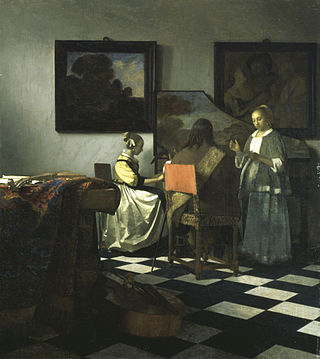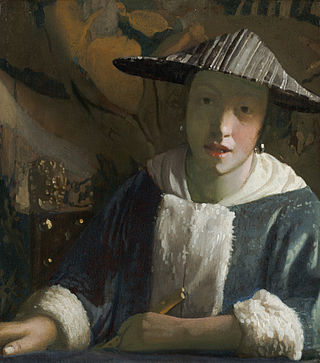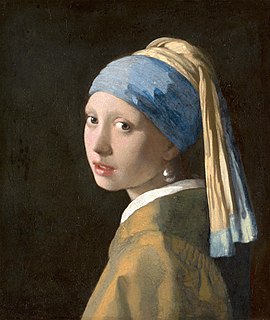
Johannes Vermeer was a Dutch Baroque Period painter who specialized in domestic interior scenes of middle-class life. He is considered one of the greatest painters of the Dutch Golden Age. During his lifetime, he was a moderately successful provincial genre painter, recognized in Delft and The Hague. He produced relatively few paintings, primarily earning his living as an art dealer. He was not wealthy; at his death, his wife was left in debt.

The Mauritshuis is an art museum in The Hague, Netherlands. The museum houses the Royal Cabinet of Paintings which consists of 854 objects, mostly Dutch Golden Age paintings. The collection contains works by Johannes Vermeer, Rembrandt van Rijn, Jan Steen, Paulus Potter, Frans Hals, Jacob van Ruisdael, Hans Holbein the Younger, and others. Originally, the 17th-century building was the residence of count John Maurice of Nassau. It is now the property of the government of the Netherlands and is listed in the top 100 Dutch heritage sites.

The Milkmaid, sometimes called The Kitchen Maid, is an oil-on-canvas painting of a "milkmaid", in fact, a domestic kitchen maid, by the Dutch artist Johannes Vermeer. It is in the Rijksmuseum in Amsterdam, the Netherlands, which regards it as "unquestionably one of the museum's finest attractions".

Girl Interrupted at Her Music is a painting by the Dutch artist Johannes Vermeer. It was painted in the baroque style, probably between the years 1658 and 1659, using oil on canvas. Since 1901 it has been in the Frick Collection in New York City.

Girl with a Pearl Earring is a 1999 historical novel written by Tracy Chevalier. Set in 17th-century Delft, Holland, the novel was inspired by local painter Johannes Vermeer's Girl with a Pearl Earring. Chevalier presents a fictional account of Vermeer, the model and the painting. The novel was adapted into a 2003 film of the same name and a 2008 play. In May 2020, BBC Radio 4 broadcast a new dramatisation of the novel.

The Concert is a painting by the Dutch artist Johannes Vermeer depicting a man and two women performing music. It was stolen on March 18, 1990, from the Isabella Stewart Gardner Museum in Boston and remains missing. Experts believe it may be the most valuable stolen object in the world; as of 2015, it was valued at US$250 million.

Study of a Young Woman is a painting by the Dutch artist Johannes Vermeer, completed between 1665 and 1667, and now in the Metropolitan Museum of Art, New York.

The Allegory of Faith, also known as Allegory of the Catholic Faith, is a Dutch Golden Age painting by Johannes Vermeer from about 1670–1672. It has been in the Metropolitan Museum of Art in New York since 1931.

Officer and Laughing Girl, also known as Officer and a Laughing Girl, Officer With a Laughing Girl or, in Dutch, De Soldaat en het Lachende Meisje, is an oil painting on canvas executed ca. 1657 by the Dutch artist Johannes Vermeer. Its dimensions are 50.5 by 46 cm. It is now one of three pictures by Vermeer in The Frick Collection in New York

Girl with a Red Hat is a rather small painting, signed by the Dutch painter Johannes Vermeer. It is seen as one of a number of Vermeer's tronies – depictions of models fancifully dressed that were not intended to be portraits of specific, identifiable subjects. Whether Vermeer chose family members as models or found them elsewhere in Delft is irrelevant to the appreciation of his paintings. Its attribution to Vermeer – as it is on a (recycled) wood panel and not on canvas – has been a matter of controversy with scholars on both sides of the argument. However, in recent study carried out by the curators of National Gallery of Art certainty has been established on the authorship of the painting by Vermeer, a conclusion also supported by Dutch experts.

View of Delft is an oil painting by Johannes Vermeer, painted c. 1659–1661. The painting of the Dutch artist's hometown is among his best known. It is one of three known paintings of Delft by Vermeer, along with The Little Street and the lost painting House Standing in Delft, and his only cityscape. According to art historian Emma Barker, cityscapes across water, which were popular in the Netherlands at the time, celebrated the city and its trade. Vermeer's View of Delft has been held in the Dutch Royal Cabinet of Paintings at the Mauritshuis in The Hague since its establishment in 1822.

Girl Reading a Letter at an Open Window, also known as Lady reading at an open window, is an oil painting by Dutch Golden Age painter Johannes Vermeer. Completed in approximately 1657–1659, the painting is on display at the Gemäldegalerie in Dresden, which has held it since 1742. For many years, the attribution of the painting—which features a young Dutch woman reading a letter before an open window—was lost, with first Rembrandt and then Pieter de Hooch being credited for the work before it was properly identified in 1880. After World War II, the painting was briefly in possession of the Soviet Union. In 2017, tests revealed that the painting had been altered after the painter's death.

Woman with a Pearl Necklace by Johannes Vermeer is a Dutch Golden Age painting of about 1664. Painted in oils on canvas, Johannes Vermeer portrayed a young Dutch woman, most likely of upper-class descent, dressing herself with two yellow ribbons, pearl earrings, and a pearl necklace. As a very popular artist of the 17th century, the Dutch Golden Age, Vermeer depicted many women in similar circumstances within interior, domestic scenes. The same woman also appears in The Love Letter and A Lady Writing a Letter.

Mistress and Maid is an oil-on-canvas painting produced by Johannes Vermeer c. 1667. It portrays two women, a mistress and her maid, as they look over the mistress' letter. The painting displays Vermeer's preference for yellow and blue, female models, and domestic scenes. It is now in the Frick Collection in New York City.

Girl with a Flute is a small painting attributed to either Johannes Vermeer or one of his associates. It is currently believed to have probably been painted between 1669–1675. It is owned by the National Gallery of Art in Washington, D.C. along with three paintings attributed to Vermeer: Woman Holding a Balance, A Lady Writing a Letter, and Girl with a Red Hat.

Girl with a Pearl Earring is a 2003 drama film directed by Peter Webber from a screenplay by Olivia Hetreed, based on the 1999 novel of the same name by Tracy Chevalier. Scarlett Johansson stars as Griet, a young 17th-century servant in the household of the Dutch painter Johannes Vermeer at the time he painted Girl with a Pearl Earring (1665) in the city of Delft in Holland. Other cast members include Tom Wilkinson, Cillian Murphy, Essie Davis, and Judy Parfitt.

The Goldfinch is a painting by the Dutch Golden Age artist Carel Fabritius of a life-sized chained goldfinch. Signed and dated 1654, it is now in the collection of the Mauritshuis in The Hague, Netherlands. The work is a trompe-l'œil oil on panel measuring 33.5 by 22.8 centimetres that was once part of a larger structure, perhaps a window jamb or a protective cover. It is possible that the painting was in its creator's workshop in Delft at the time of the gunpowder explosion that killed him and destroyed much of the city.
Awol Erizku is an Ethiopian-born American contemporary artist. His primary media are painting, photography, sculpture and film. Erizku works with a wide variety of found materials. Erizku was dubbed "the art world's new 'it' boy" by Vulture Magazine in 2016. He lives in New York City and Los Angeles.

Johannes Vermeer was a Dutch Baroque Period painter who specialized in domestic interior scenes of middle class life. His works have been a common theme in literature and films in popular culture since the rediscovery of his works by 20th century art scholars.
Girl with a Pierced Eardrum is a 2014 mural by anonymous street artist Banksy, on the wall of a building in Hanover Place, Spike Island, Bristol, England. Appearing overnight on 20 October 2014, it is a parody of Girl with a Pearl Earring, c. 1665 by Johannes Vermeer, instead replacing the pearl earring with an existing security alarm.


















